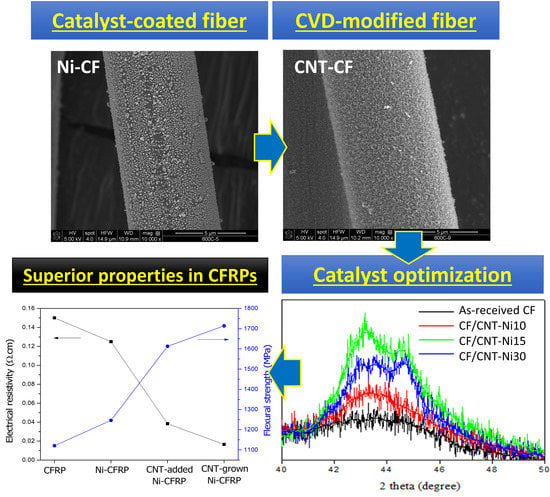Enhanced Surface Energetics of CNT-Grafted Carbon Fibers for Superior Electrical and Mechanical Properties in CFRPs
Abstract
1. Introduction
- Optimization of catalyst weight on CF substrate for the highest surface energetics and crystallinity of grafting CNTs.
- Revealing the correlation between the crystallite size and surface energy of the as-grown carbon structures.
- Revealing the effect of optimized CNT-growth to achieve superior electrical and mechanical properties in CFRPs.
- Insights on the effect of CNTs as the secondary filler on the ductile response of respective CFRPs.
2. Experimental Details
2.1. Materials
2.2. Ni Electroplating of CFs
2.3. CVD-Assisted Growth of CNTs
2.4. CFRP Fabrication
2.5. Characterizations
2.5.1. Crystallite Size
2.5.2. Surface Energetics
- The contact angles of two probe liquids were individually measured against neat cured-epoxy substrates. To achieve a smooth surface, the substrate was sequentially polished with sandpaper prior to the measurement. Measurement was done several times to ensure the reliability of the analysis.
- The measured contact angles were then used as inputs for an image analysis program, Surfaceware 9, Surface Electro Optics SEO Ltd., Suwon-si, Korea. Owens-Wendt’s theory [23] was used to determine the polar and dispersive components of SFE of the epoxy samples.
- The weight of the dry fibers was automatically tared by the instrument.
- Wilhelmy plate method [24] was employed to measure the interfacial tension at the fiber-liquid interface. The filaments were oriented parallel to the gravity axis and partly immersed in the probe liquid. The free end of the fiber in the air was connected to a micro-scale to measure the force required to pull out the fiber from the liquid.
- Liquid-fiber contact angle and wetted perimeter of fiber surface were measured.
- Equation (2) (or Equation (3)) was then used to determine the SFE value of monofilaments.
3. Results and Discussion
3.1. Morphology of As-Prepared CFs
3.2. Surface Energetics
3.3. CFRP Electrical Resistivity (Specific Electrical Resistance)
3.4. CFRP Mechanical Properties
4. Conclusions
- In this work, Ni at 15 wt.% showed the highest yield of CNTs. This was explained by the correlation between the carbon crystallite size and surface free energy of CNT-grafted CFs. We showed that better purity of the CNT structure and larger graphitic lattice size can be achieved by simply optimizing the catalyst weight ratio. The presence of a multi-phase (crystalline and amorphous) carbonaceous structure, which is unfavorable for obtaining a high surface area, can be minimized using the proposed method.
- The electrical resistivity of CNT-grown Ni-CFRP was found to be about 9, 7.5, and 2.3 times lower than those of as-received CFRP, Ni-CFRP, and CNT-added Ni-CFRP, respectively.
- Results of the 3-point bending test show a 52.9% improvement in the flexural strength of CNT-grown Ni-CFRPs compared with that of virgin CFRP samples.
- The ductility test confirmed that CNT growth was in a tip-growth manner. The highest ductility index was obtained for CNT-added Ni-CFRP, where Ni-CFRP and CNT-grown Ni-CFRP had approximately the same indices. This shows that even mere addition of CNT powder can highly improve the load-bearing performance of CFRPs. Moreover, it should be noted that the CNT aspect ratio can be highly influential in CNT-added Ni-CFRP properties.
Author Contributions
Funding
Acknowledgments
Conflicts of Interest
References
- Palmieri, F.L.; Ledesma, R.I.; Dennie, J.G.; Kramer, T.J.; Lin, Y.; Hopkins, J.W.; Wohl, C.J.; Connell, J.W. Optimized surface treatment of aerospace composites using a picosecond laser. Compos. Part B Eng. 2019, 175, 107155. [Google Scholar] [CrossRef]
- Nguyen, K.T.Q.; Navaratnam, S.; Mendis, P.; Zhang, K.; Barnett, J.; Wang, H. Fire safety of composites in prefabricated buildings: From fibre reinforced polymer to textile reinforced concrete. Compos. Part B Eng. 2020, 187, 107815. [Google Scholar] [CrossRef]
- Rohani, H.; Badakhsh, A.; Park, C.W. Thermal performance of modified polymeric heatsinks as an alternative for aluminum in heat rejection systems. Appl. Therm. Eng. 2019, 159, 113823. [Google Scholar] [CrossRef]
- Badakhsh, A.; An, K.-H.; Park, C.W.; Kim, B.-J. Effects of Biceramic AlN-SiC Microparticles on the Thermal Properties of Paraffin for Thermal Energy Storage. J. Nanomater. 2018, 2018, 8632350. [Google Scholar] [CrossRef]
- Balla, V.K.; Kate, K.H.; Satyavolu, J.; Singh, P.; Tadimeti, J.G.D. Additive manufacturing of natural fiber reinforced polymer composites: Processing and prospects. Compos. Part B Eng. 2019, 174, 106956. [Google Scholar] [CrossRef]
- Sun, T.; Li, M.; Zhou, S.; Liang, M.; Chen, Y.; Zou, H. Multi-scale structure construction of carbon fiber surface by electrophoretic deposition and electropolymerization to enhance the interfacial strength of epoxy resin composites. Appl. Surf. Sci. 2020, 499, 143929. [Google Scholar] [CrossRef]
- Shen, W.; Ma, R.; Du, A.; Cao, X.; Hu, H.; Wu, Z.; Zhao, X.; Fan, Y.; Cao, X. Effect of carbon nanotubes and octa-aminopropyl polyhedral oligomeric silsesquioxane on the surface behaviors of carbon fibers and mechanical performance of composites. Appl. Surf. Sci. 2018, 447, 894–901. [Google Scholar] [CrossRef]
- Raphael, N.; Namratha, K.; Chandrashekar, B.N.; Sadasivuni, K.K.; Ponnamma, D.; Smitha, A.S.; Krishnaveni, S.; Cheng, C.; Byrappa, K. Surface modification and grafting of carbon fibers: A route to better interface. Prog. Cryst. Growth Charact. Mater. 2018, 64, 75–101. [Google Scholar] [CrossRef]
- Badakhsh, A.; Han, W.; Jung, S.-C.; An, K.-H.; Kim, B.-J. Preparation of Boron Nitride-Coated Carbon Fibers and Synergistic Improvement of Thermal Conductivity in Their Polypropylene-Matrix Composites. Polymers 2019, 11. [Google Scholar] [CrossRef]
- Kim, K.-W.; Jeong, J.-S.; An, K.-H.; Kim, B.-J. A study on the microstructural changes and mechanical behaviors of carbon fibers induced by optimized electrochemical etching. Compos. Part B Eng. 2019, 165, 764–771. [Google Scholar] [CrossRef]
- Ansaldo, A.; Haluška, M.; Čech, J.; Meyer, J.C.; Ricci, D.; Gatti, F.; Di Zitti, E.; Cincotti, S.; Roth, S. A study of the effect of different catalysts for the efficient CVD growth of carbon nanotubes on silicon substrates. Phys. E Low-Dimensional Syst. Nanostruct. 2007, 37, 6–10. [Google Scholar] [CrossRef]
- Wei, Y.Y.; Eres, G.; Merkulov, V.I.; Lowndes, D.H. Effect of catalyst film thickness on carbon nanotube growth by selective area chemical vapor deposition. Appl. Phys. Lett. 2001, 78, 1394–1396. [Google Scholar] [CrossRef]
- Atthipalli, G.; Epur, R.; Kumta, P.N.; Yang, M.; Lee, J.-K.; Gray, J.L. Nickel Catalyst-Assisted Vertical Growth of Dense Carbon Nanotube Forests on Bulk Copper. J. Phys. Chem. C 2011, 115, 3534–3538. [Google Scholar] [CrossRef]
- Meng, L.-Y.; Moon, C.-W.; Im, S.-S.; Lee, K.-H.; Byun, J.-H.; Park, S.-J. Effect of Ni catalyst dispersion on the growth of carbon nanofibers onto carbon fibers. Microporous Mesoporous Mater. 2011, 142, 26–31. [Google Scholar] [CrossRef]
- Du, X.; Xu, F.; Liu, H.-Y.; Miao, Y.; Guo, W.-G.; Mai, Y.-W. Improving the electrical conductivity and interface properties of carbon fiber/epoxy composites by low temperature flame growth of carbon nanotubes. RSC Adv. 2016, 6, 48896–48904. [Google Scholar] [CrossRef]
- Wang, C.; Li, Y.; Tong, L.; Song, Q.; Li, K.; Li, J.; Peng, Q.; He, X.; Wang, R.; Jiao, W.; et al. The role of grafting force and surface wettability in interfacial enhancement of carbon nanotube/carbon fiber hierarchical composites. Carbon 2014, 69, 239–246. [Google Scholar] [CrossRef]
- Bedi, H.S.; Padhee, S.S.; Agnihotri, P.K. Effect of carbon nanotube grafting on the wettability and average mechanical properties of carbon fiber/polymer multiscale composites. Polym. Compos. 2018, 39, E1184–E1195. [Google Scholar] [CrossRef]
- Guignier, C.; Bueno, M.-A.; Camillieri, B.; Durand, B. Influence of composite processing on the properties of CNT grown on carbon surfaces. Appl. Surf. Sci. 2018, 428, 835–843. [Google Scholar] [CrossRef]
- Fan, W.; Wang, Y.; Wang, C.; Chen, J.; Wang, Q.; Yuan, Y.; Niu, F. High efficient preparation of carbon nanotube-grafted carbon fibers with the improved tensile strength. Appl. Surf. Sci. 2016, 364, 539–551. [Google Scholar] [CrossRef]
- Boroujeni, A.Y.; Al-Haik, M. Carbon nanotube – Carbon fiber reinforced polymer composites with extended fatigue life. Compos. Part B Eng. 2019, 164, 537–545. [Google Scholar] [CrossRef]
- Scherrer, P. Nachr Ges Wiss Goettingen. Math. Phys. 1918, 2, 98–100. [Google Scholar]
- Holzwarth, U.; Gibson, N. The Scherrer equation versus the ‘Debye-Scherrer equation’. Nat. Nanotechnol. 2011, 6, 534. [Google Scholar] [CrossRef] [PubMed]
- Owens, D.K.; Wendt, R.C. Estimation of the surface free energy of polymers. J. Appl. Polym. Sci. 1969, 13, 1741–1747. [Google Scholar] [CrossRef]
- Wilhelmy, L. Ueber die Abhängigkeit der Capillaritäts-Constanten des Alkohols von Substanz und Gestalt des benetzten festen Körpers. Anna. Physik 1863, 195, 177–217. [Google Scholar] [CrossRef]
- Kim, K.J.; Yu, W.-R.; Youk, J.H.; Lee, J. Factors governing the growth mode of carbon nanotubes on carbon-based substrates. Phys. Chem. Chem. Phys. 2012, 14, 14041–14048. [Google Scholar] [CrossRef]
- Flygare, M.; Svensson, K. Quantifying crystallinity in carbon nanotubes and its influence on mechanical behaviour. Mater. Today Commun. 2019, 18, 39–45. [Google Scholar] [CrossRef]
- Badakhsh, A.; Lee, Y.-M.; Rhee, K.Y.; Park, C.W.; An, K.-H.; Kim, B.-J. Improvement of thermal, electrical and mechanical properties of composites using a synergistic network of length controlled-CNTs and graphene nanoplatelets. Compos. Part B Eng. 2019, 175, 107075. [Google Scholar] [CrossRef]
- Pozegic, T.R.; Hamerton, I.; Anguita, J.V.; Tang, W.; Ballocchi, P.; Jenkins, P.; Silva, S.R.P. Low temperature growth of carbon nanotubes on carbon fibre to create a highly networked fuzzy fibre reinforced composite with superior electrical conductivity. Carbon 2014, 74, 319–328. [Google Scholar] [CrossRef]
- Zhao, Z.J.; Zhang, B.Y.; Du, Y.; Hei, Y.W.; Yi, X.S.; Shi, F.H.; Xian, G.J. MWCNT modified structure-conductive composite and its electromagnetic shielding behavior. Compos. Part B Eng. 2017, 130, 21–27. [Google Scholar] [CrossRef]
- Lee, S.; Ko, K.; Youk, J.; Lim, D.; Jeong, W. Preparation and Properties of Carbon Fiber/Carbon Nanotube Wet-Laid Composites. Polymers 2019, 11. [Google Scholar] [CrossRef]
- Burkov, M.; Eremin, A. Hybrid CFRP/SWCNT Composites with Enhanced Electrical Conductivity and Mechanical Properties. J. Mater. Eng. Perform. 2018, 27, 5984–5991. [Google Scholar] [CrossRef]
- Duongthipthewa, A.; Su, Y.; Zhou, L. Electrical conductivity and mechanical property improvement by low-temperature carbon nanotube growth on carbon fiber fabric with nanofiller incorporation. Compos. Part B Eng. 2020, 182, 107581. [Google Scholar] [CrossRef]
- Fogel, M.; Parlevliet, P.; Olivier, P.; Dantras, É. Manufacturing of conductive structural composites through spraying of CNTs/epoxy dispersions on dry carbon fiber plies. Compos. Part A Appl. Sci. Manuf. 2017, 100, 40–47. [Google Scholar] [CrossRef]
- Russello, M.; Diamanti, E.K.; Catalanotti, G.; Ohlsson, F.; Hawkins, S.C.; Falzon, B.G. Enhancing the electrical conductivity of carbon fibre thin-ply laminates with directly grown aligned carbon nanotubes. Compos. Struct. 2018, 206, 272–278. [Google Scholar] [CrossRef]
- Quan, D.; Mischo, C.; Li, X.; Scarselli, G.; Ivanković, A.; Murphy, N. Improving the electrical conductivity and fracture toughness of carbon fibre/epoxy composites by interleaving MWCNT-doped thermoplastic veils. Compos. Sci. Technol. 2019, 182, 107775. [Google Scholar] [CrossRef]
- Kumar, V.; Sharma, S.; Pathak, A.; Singh, B.P.; Dhakate, S.R.; Yokozeki, T.; Okada, T.; Ogasawara, T. Interleaved MWCNT buckypaper between CFRP laminates to improve through-thickness electrical conductivity and reducing lightning strike damage. Compos. Struct. 2019, 210, 581–589. [Google Scholar] [CrossRef]
- Chou, T.Y.; Tsai, H.-Y.; Yip, M.C. Preparation of CFRP with modified MWCNT to improve the mechanical properties and torsional fatigue of epoxy/polybenzoxazine copolymer. Compos. Part A Appl. Sci. Manuf. 2019, 118, 30–40. [Google Scholar] [CrossRef]
- Khan, S.; Singh Bedi, H.; Agnihotri, P.K. Augmenting mode-II fracture toughness of carbon fiber/epoxy composites through carbon nanotube grafting. Eng. Fract. Mech. 2018, 204, 211–220. [Google Scholar] [CrossRef]
- Rong, H.; Dahmen, K.-H.; Garmestani, H.; Yu, M.; Jacob, K.I. Comparison of chemical vapor deposition and chemical grafting for improving the mechanical properties of carbon fiber/epoxy composites with multi-wall carbon nanotubes. J. Mater. Sci. 2013, 48, 4834–4842. [Google Scholar] [CrossRef]
- Wu, X.; Zhu, Y. Heterogeneous materials: A new class of materials with unprecedented mechanical properties. Mater. Res. Lett. 2017, 5, 527–532. [Google Scholar] [CrossRef]
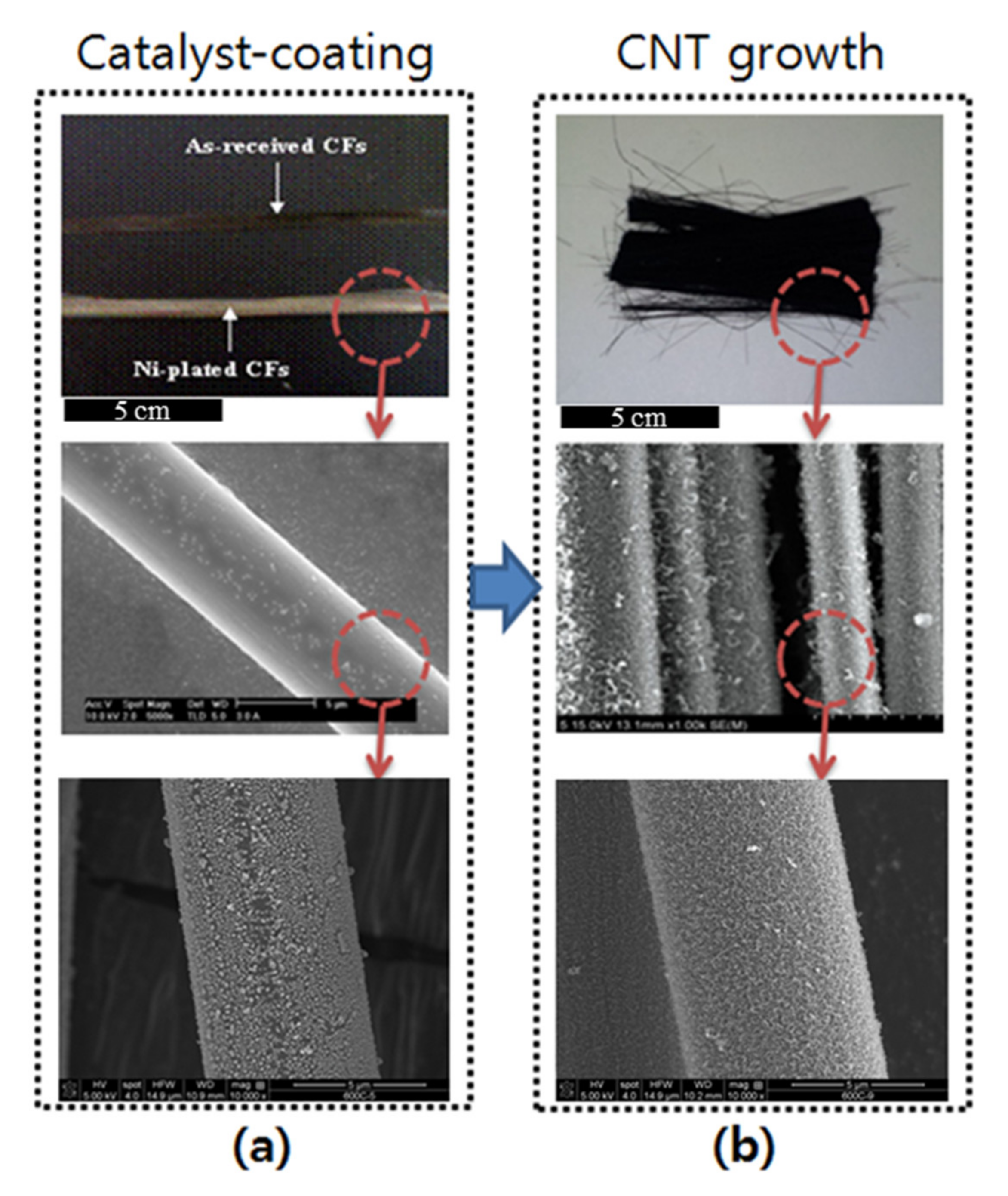
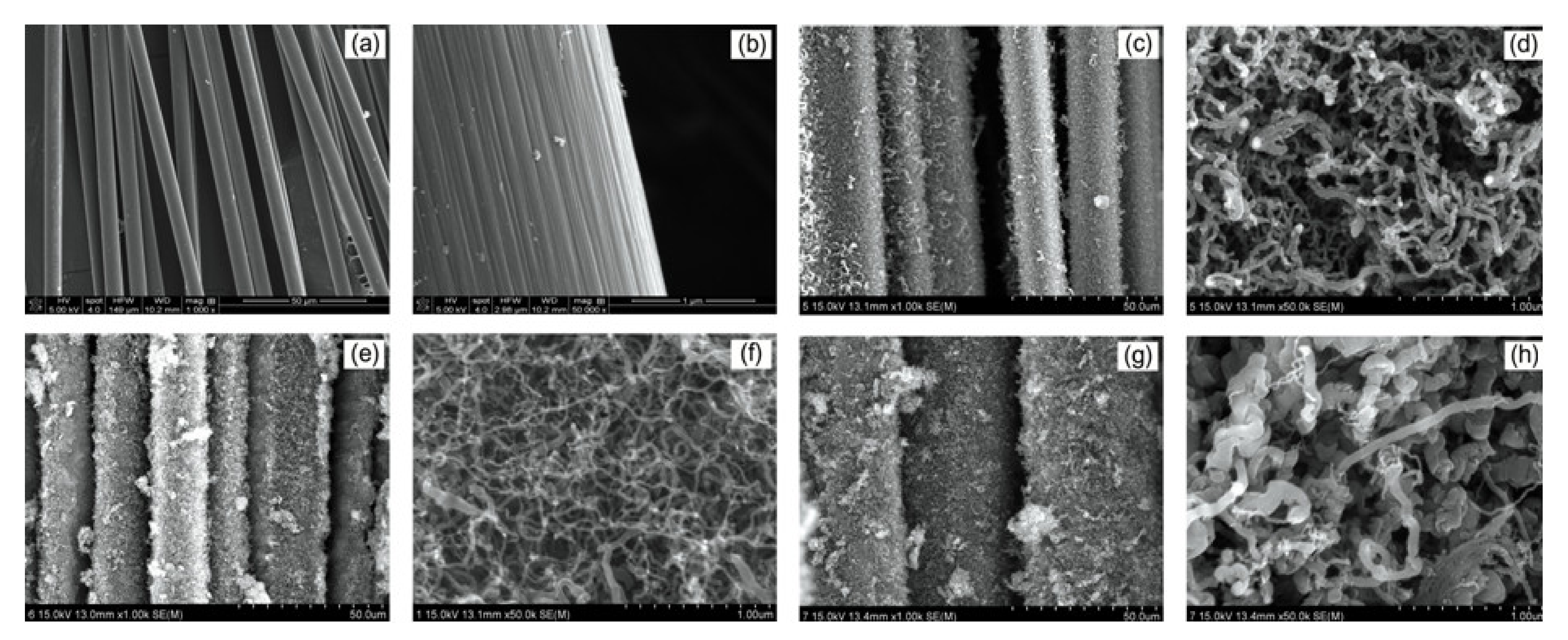
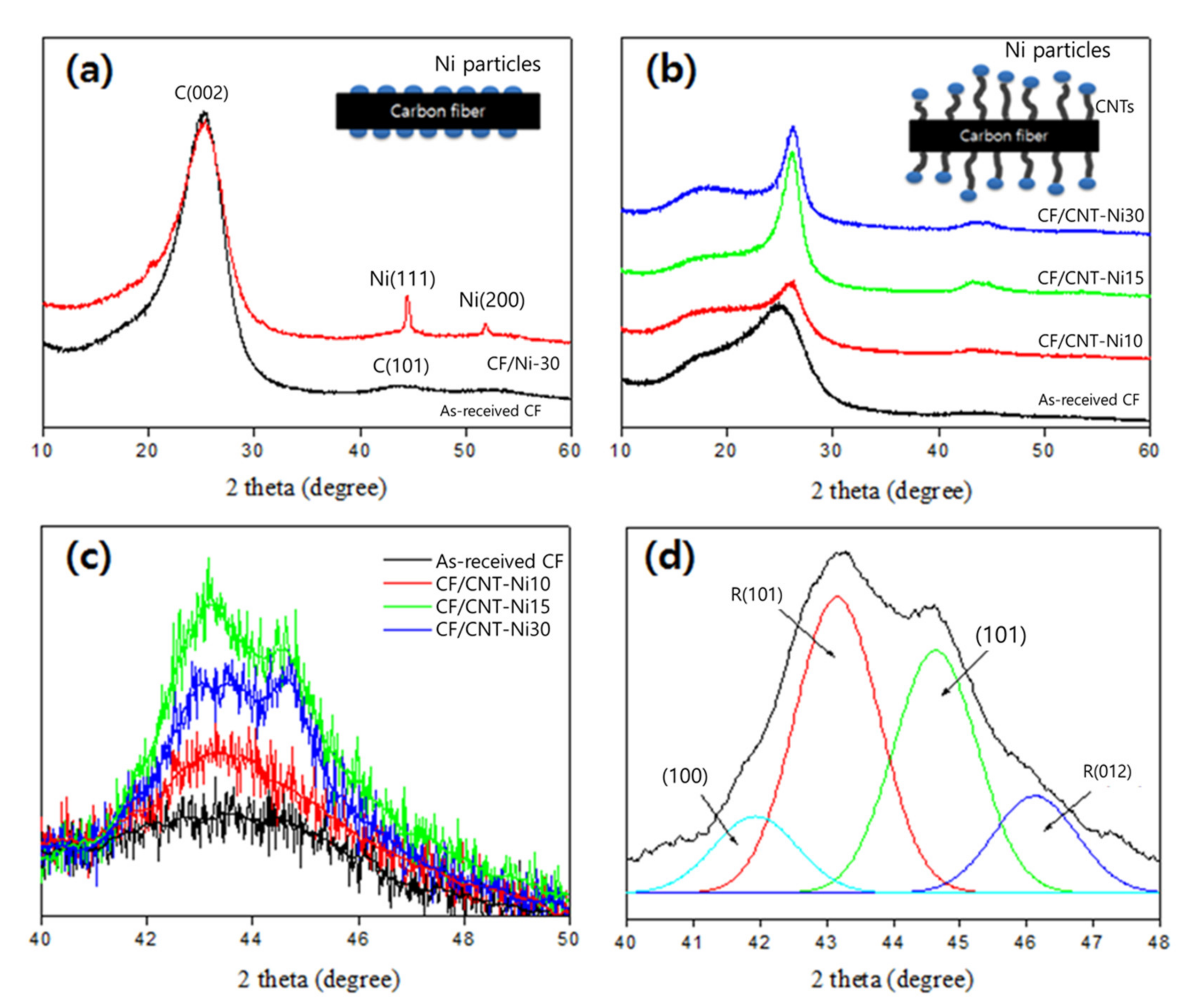
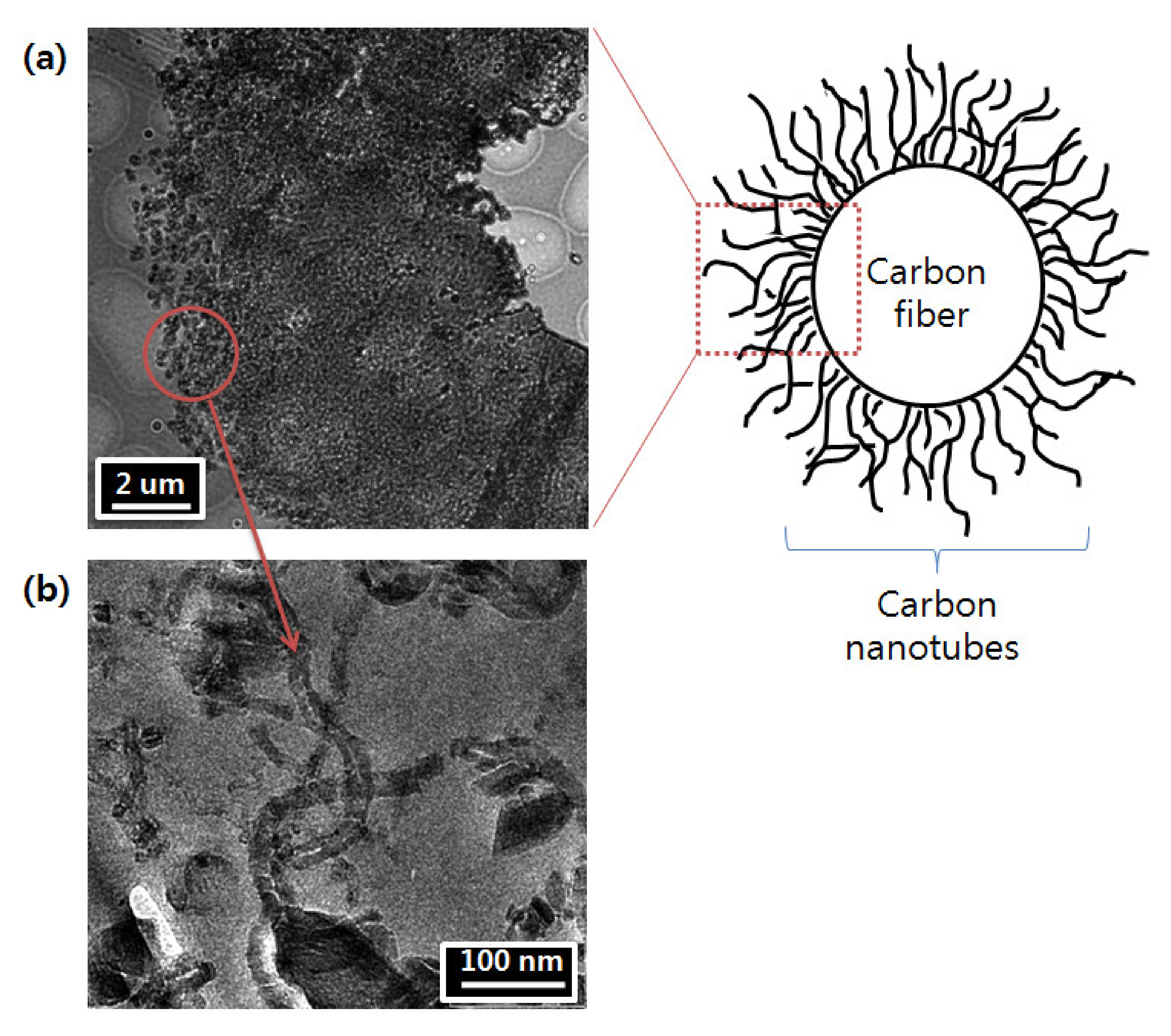
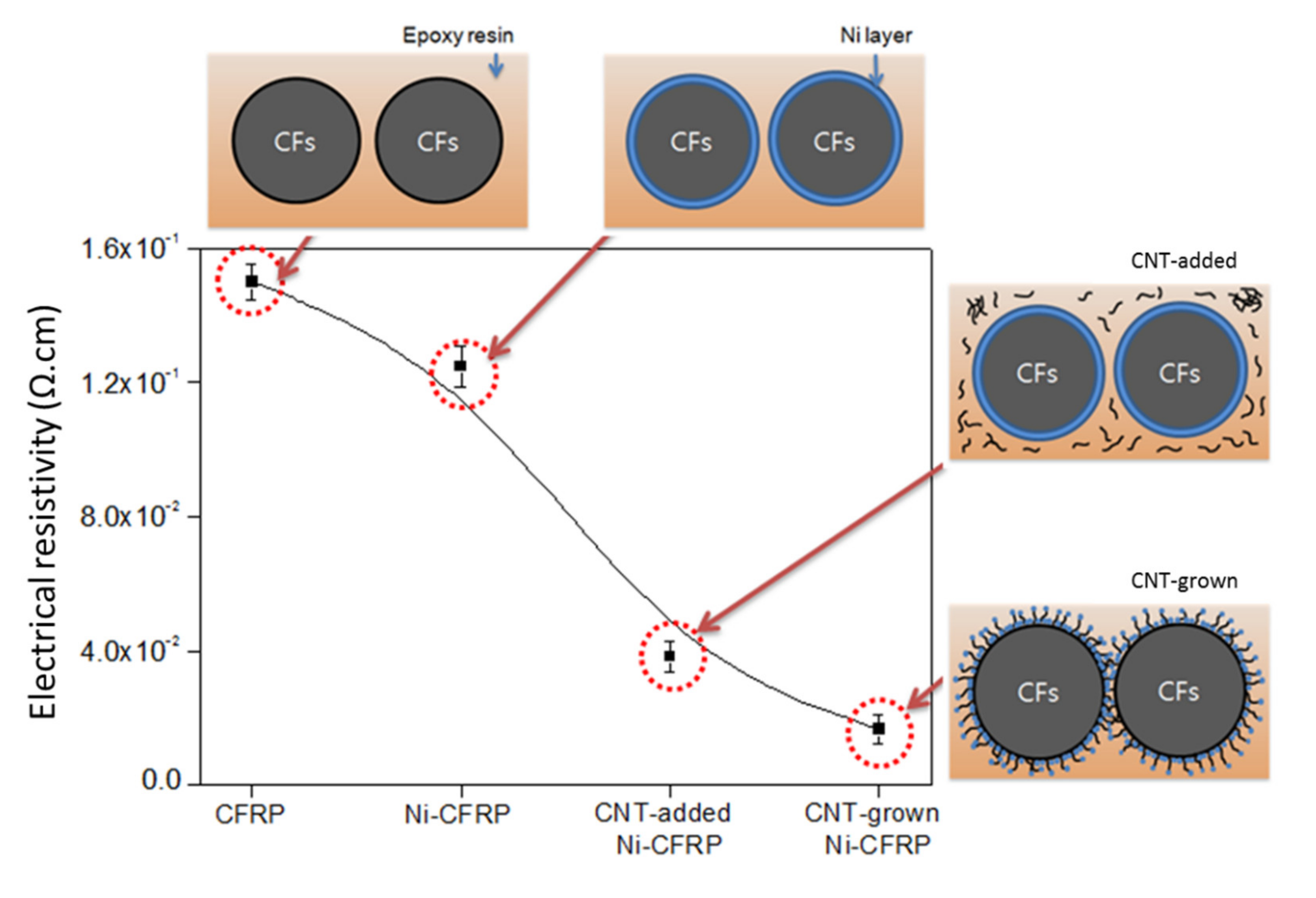
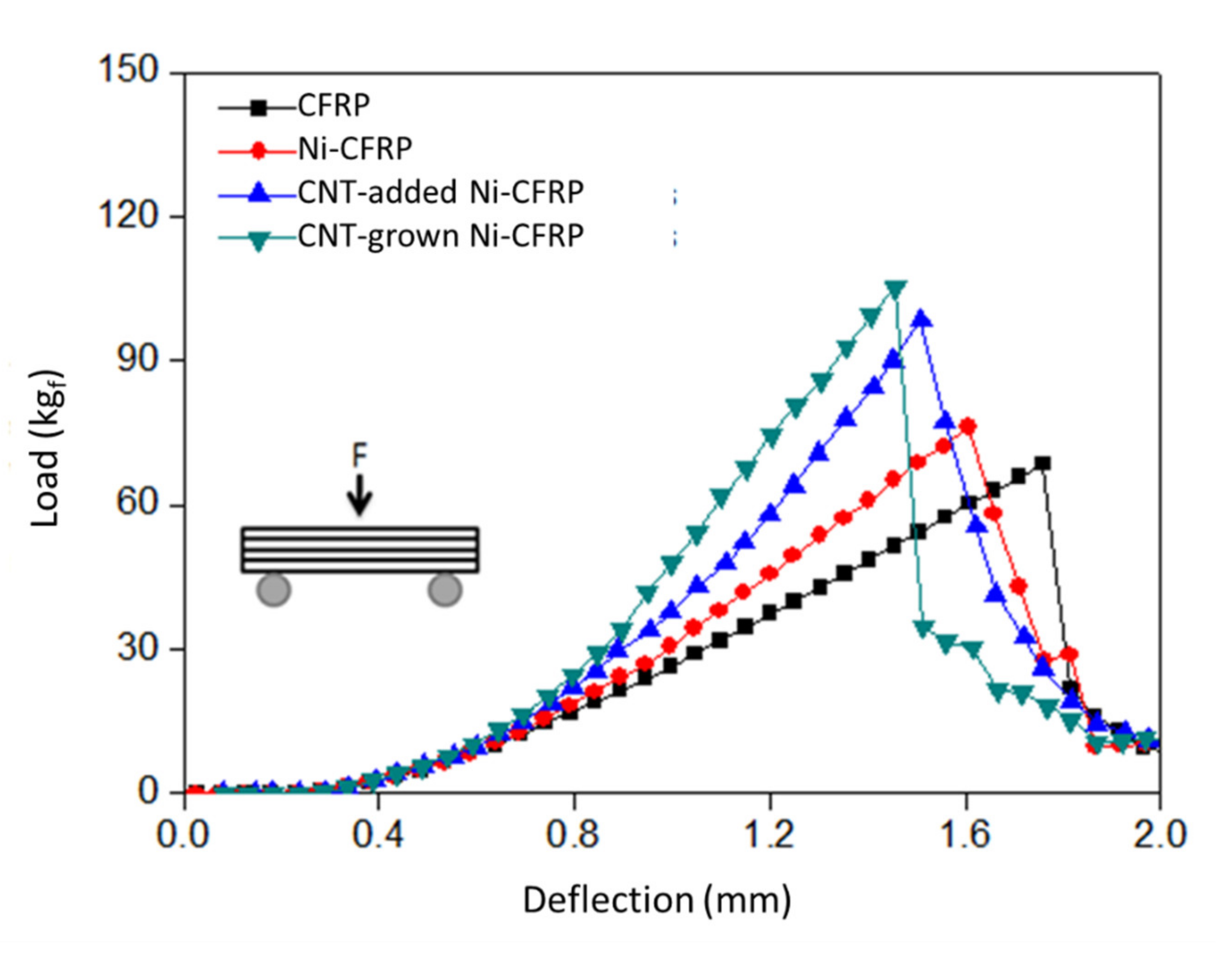
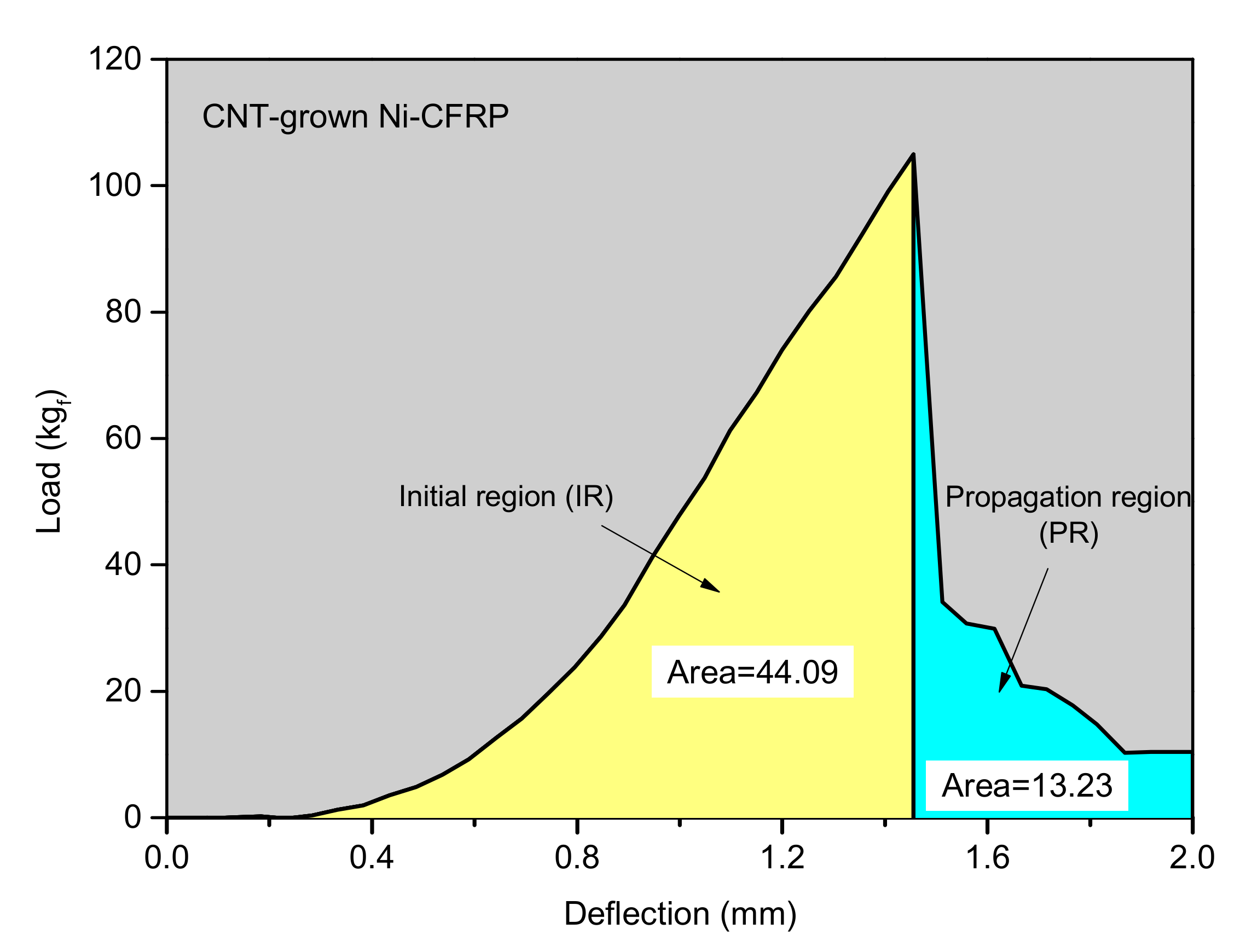
| Sample | 2θ (°) | d002 (nm) 1 | FWHM (°) 2 | Crystallite Size (Lc, nm) |
|---|---|---|---|---|
| As-received CF | 24.90 | 0.357 | 5.77 | 1.40 |
| CF/CNT-Ni10 | 25.95 | 0.343 | 3.43 | 2.35 |
| CF/CNT-Ni15 | 26.14 | 0.341 | 1.77 | 4.56 |
| CF/CNT-Ni30 | 26.25 | 0.339 | 1.97 | 4.10 |
| Sample | WA (mN/m) | |||
|---|---|---|---|---|
| As-received CF | 3.53 | 22.58 | 26.11 | 76.8 |
| CF/CNT-Ni10 | 28.52 | 113.37 | 141.89 | 178.9 |
| CF/CNT-Ni15 | 35.89 | 140.30 | 176.19 | 199.4 |
| CF/CNT-Ni30 | 13.12 | 93.62 | 106.74 | 155.2 |
| Study | Reinforcement | Enhancement (%) |
|---|---|---|
| Present work | 1.8 wt.% MWCNT to prepare 60 wt.% 3-ply CFRPs | 809% |
| [15] | MWCNTs grown on CF fabrics to prepare 2-ply CFRPs | >170 |
| [28] | MWCNTs grown on CF fabrics to prepare x-ply CFRPs | 510 in thru-plane direction 330 in in-plane direction |
| [29] | MWCNTs added at 8 wt.% to prepare 4-ply CFRPs (sanded surface were measured) | 789 |
| [30] | MWCNTs added at 20 wt.% to prepare 0.1 wt.% short CFRPs | 500 |
| [31] | SWCNTs added at 0.3 wt.% to prepare 12-ply CFRPs | Very high in thru-plane direction (compared with dielectric virgin CFRP) 53.37 in the in-plane direction |
| [32] | GNP at 0.2 wt.% was added and MWCNTs grown on CFs to prepare 16-ply CFRPs | 440 |
| [33] | MWCNTs added at 0.75 wt.% to prepare 60 vol.% CF composites | 282 |
| [34] | MWCNTs were grown on CFs to prepare thin-ply CFRPs | 654 for epoxy-based CFRPs 2667.6 for polypropylene-based CFRPs |
| [35] | MWCNTs solution (0.002 g/L) added to prepare 26-ply CFRPs | 543 |
| [36] | MWCNT buckypaper sheets added to prepare 8-ply CFRPs | 697 |
| Sample | σ (MPa) | DI |
|---|---|---|
| As-received CFRPs | 1120.88 ± 3% | 0.21 ± 3% |
| Ni-CFRPs | 1246.41 ± 3% | 0.29 ± 3% |
| CNT-added Ni-CFRPs | 1612.89 ± 3% | 0.42 ± 3% |
| CNT-grown Ni-CFRPs | 1713.89 ± 3% | 0.30 ± 3% |
| Study | Reinforcement | Enhancement (%) |
|---|---|---|
| Present work | 1.8 wt.% MWCNT to prepare 60 wt.% 3-ply CFRPs | 52.9 |
| [29] | MWCNTs added at 8 wt.% to prepare 4-ply CFRPs | 2.7 |
| [31] | SWCNTs added at 0.3 wt.% to prepare 12-ply CFRPs | 22.6 |
| [32] | GNP at 0.2 wt.% was added and MWCNTs grown on CFs to prepare 16-ply CFRPs | 19 |
| [37] | MWCNTs added at 0.5 wt.% to prepare 8-ply CFRPs | 19.7 |
| [38] | MWCNTs grown on CFs to prepare 6-ply CFRPs | 5 |
| [39] | MWCNTs grown on CF to prepare CFRP containing 5 wt.% reinforcement | 36.7 |
© 2020 by the authors. Licensee MDPI, Basel, Switzerland. This article is an open access article distributed under the terms and conditions of the Creative Commons Attribution (CC BY) license (http://creativecommons.org/licenses/by/4.0/).
Share and Cite
Badakhsh, A.; An, K.-H.; Kim, B.-J. Enhanced Surface Energetics of CNT-Grafted Carbon Fibers for Superior Electrical and Mechanical Properties in CFRPs. Polymers 2020, 12, 1432. https://doi.org/10.3390/polym12061432
Badakhsh A, An K-H, Kim B-J. Enhanced Surface Energetics of CNT-Grafted Carbon Fibers for Superior Electrical and Mechanical Properties in CFRPs. Polymers. 2020; 12(6):1432. https://doi.org/10.3390/polym12061432
Chicago/Turabian StyleBadakhsh, Arash, Kay-Hyeok An, and Byung-Joo Kim. 2020. "Enhanced Surface Energetics of CNT-Grafted Carbon Fibers for Superior Electrical and Mechanical Properties in CFRPs" Polymers 12, no. 6: 1432. https://doi.org/10.3390/polym12061432
APA StyleBadakhsh, A., An, K.-H., & Kim, B.-J. (2020). Enhanced Surface Energetics of CNT-Grafted Carbon Fibers for Superior Electrical and Mechanical Properties in CFRPs. Polymers, 12(6), 1432. https://doi.org/10.3390/polym12061432






